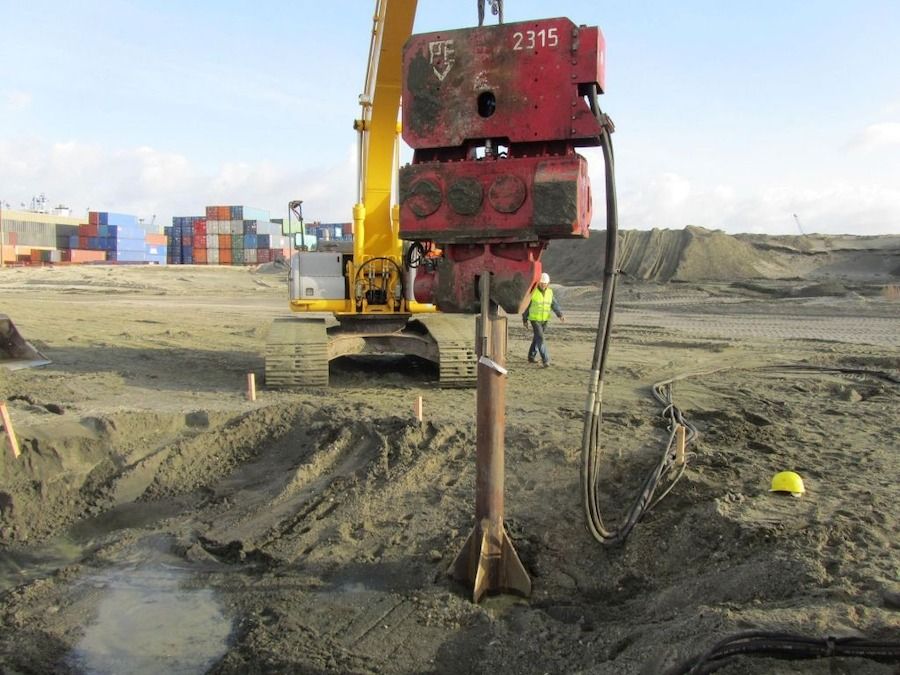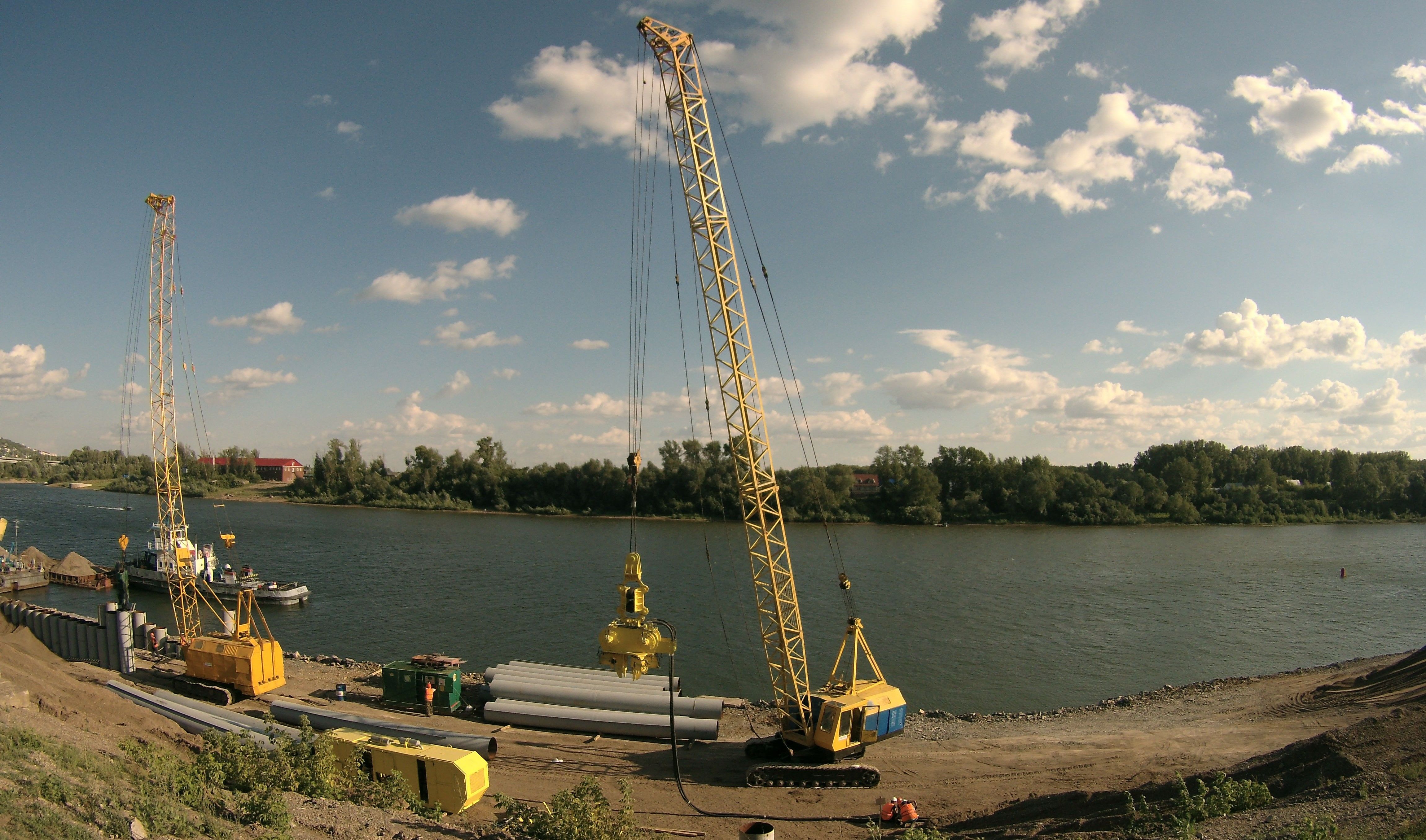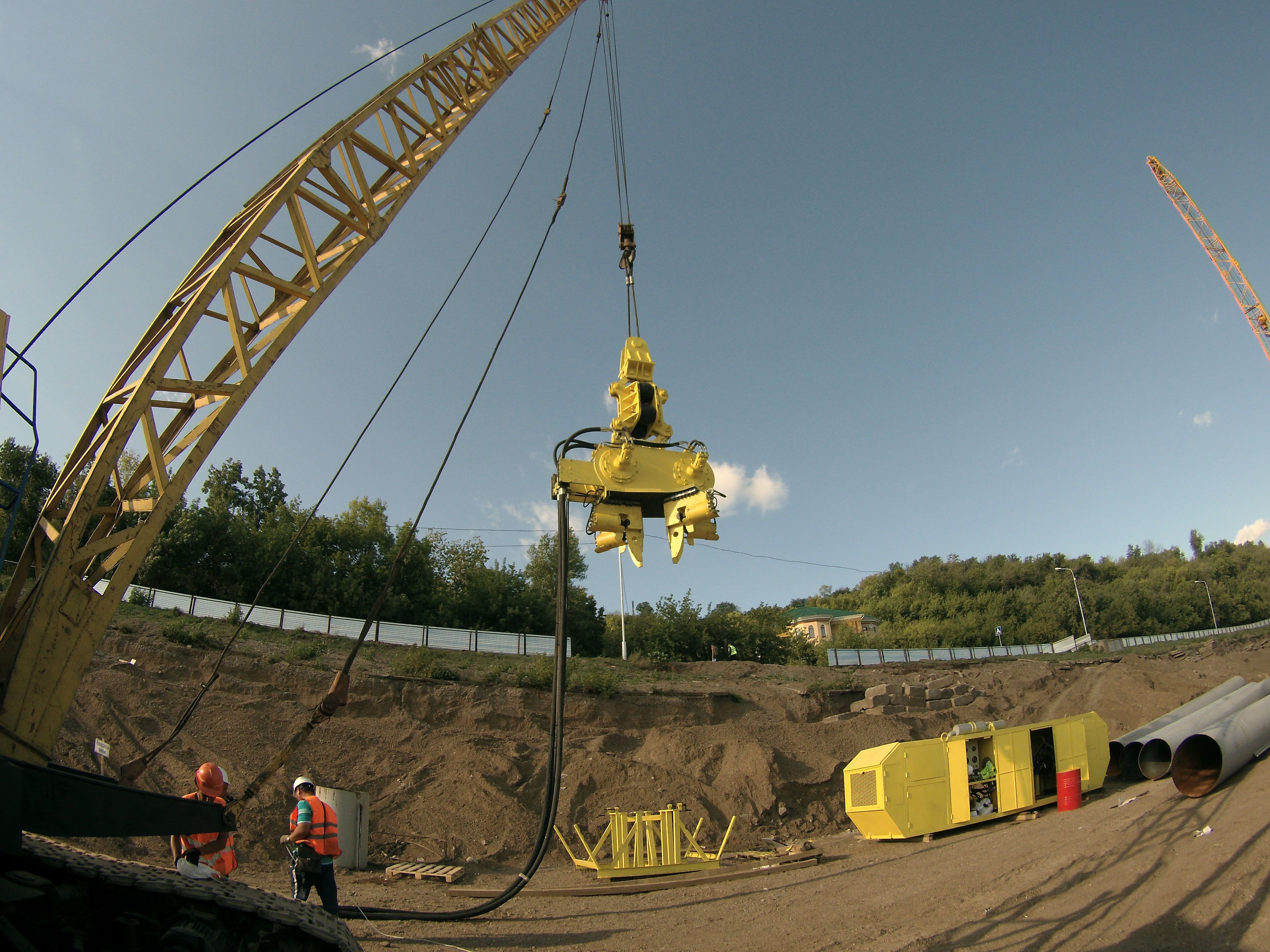The Evolution of Pile Driving Technology
Historical Development of Pile Driving Methods
Pile driving has played a crucial role in construction for centuries, evolving from primitive manual techniques to highly sophisticated mechanical systems. Ancient civilizations used wooden piles driven into soft ground to create stable foundations for buildings and bridges. Over time, manual labor gave way to steam-powered pile drivers, which increased efficiency and allowed for deeper foundations.
By the mid-20th century, diesel impact hammers became the industry standard, providing more force and speed for driving steel and concrete piles into the ground. These early innovations laid the groundwork for modern piling technologies, which prioritize speed, precision, and environmental considerations.
Transition from Manual Impact Hammers to Advanced Hydraulic and Vibratory Systems
Traditional impact hammers rely on repetitive force to drive piles into the ground. While effective, these methods often create excessive noise, vibration, and environmental disturbances. Advancements in hydraulic and vibratory systems have improved efficiency and minimized negative impacts.
- Hydraulic pile drivers provide controlled force, reducing structural damage and noise pollution.
- Vibratory hammers use oscillations to reduce soil resistance, making pile installation faster and smoother.
- Hybrid systems combine impact and vibration techniques for optimized performance in various soil conditions.
These modern approaches have significantly reduced pile installation times and increased adaptability for different soil types.
The Growing Need for Automation, Precision, and Eco-Friendly Practices
As urbanization and environmental concerns grow, the construction industry is shifting toward automated, data-driven, and sustainable piling solutions. Automation improves accuracy and reduces labor costs, while eco-friendly techniques help meet regulatory requirements for noise and emissions.
- Automated pile driving reduces human error and improves placement precision.
- AI-powered monitoring systems optimize impact force and vibration levels.
- Green construction initiatives encourage the use of low-emission equipment and sustainable pile materials.
The future of pile driving technology lies in efficiency, sustainability, and precision-driven automation.
Smart Automation and Robotics in Pile Driving
Automated Piling Systems: Reducing Human Error and Increasing Efficiency
Introduction to Automated Pile Drivers
Automation in pile driving is transforming the construction industry by reducing dependency on manual labor and enhancing accuracy. Automated pile drivers are equipped with pre-programmed sequences that adjust force, depth, and positioning in real time. These systems minimize variability and ensure consistent performance.
Minimizing Labor Costs and Increasing Accuracy
Automated systems eliminate many of the uncertainties associated with traditional piling methods. They:
- Reduce the need for large on-site labor teams.
- Improve accuracy by eliminating human errors in pile positioning.
- Optimize driving force based on soil conditions, preventing overdriving or misalignment.
Benefits of Remote-Controlled and Semi-Autonomous Piling Rigs
In hazardous environments such as offshore drilling and high-risk excavation sites, remote-controlled piling rigs enhance safety. Operators can manage pile installation from a distance, reducing exposure to dangerous conditions.
- Semi-autonomous systems adjust pile force and positioning in real time.
- Remote-controlled rigs allow operators to monitor and control multiple machines simultaneously.
- Safety enhancements reduce workplace accidents and improve efficiency.
Case Study: Increased Efficiency in Large-Scale Infrastructure Projects
A recent infrastructure project implemented fully automated pile driving systems to construct bridge foundations in an urban setting. The results showed:
- A 30 percent reduction in installation time compared to traditional methods.
- Improved precision in pile placement, leading to increased structural stability.
- Lower labor costs, reducing overall project expenses.
The successful adoption of automated piling systems demonstrates the potential for increased efficiency and cost-effectiveness in large-scale construction projects.
Robotic Pile Drivers: Enhancing Precision in Difficult Terrains
Role of Robotic Pile Drivers in High-Risk Environments
Difficult terrains, including offshore sites and extreme weather conditions, require highly precise piling solutions. Robotic pile drivers use GPS and sensor technology to enhance accuracy in such conditions.
- Offshore wind farms benefit from robotic pile drivers that ensure precision despite strong ocean currents.
- High-altitude and mountainous regions require automated systems for accurate pile placement.
- Extreme temperature environments demand robotic drivers with adaptive force control.
How GPS-Guided Systems and Sensors Improve Pile Placement
Modern robotic pile drivers integrate advanced GPS and sensor technology to achieve near-perfect alignment. These systems:
- Continuously monitor pile depth and resistance.
- Adjust hammer force dynamically based on soil feedback.
- Provide real-time data for construction teams to optimize project timelines.
Real-World Example: Wind Farm Foundation Installation
A wind energy project off the coast of Denmark used robotic pile drivers to install deep foundation piles for offshore turbines. Results included:
- 98 percent placement accuracy, reducing rework costs.
- Lower impact on marine ecosystems, meeting environmental regulations.
- Improved structural durability, ensuring long-term stability against ocean forces.
Robotic piling innovations are paving the way for safer and more precise construction in challenging environments.
AI-Driven Data Analysis for Pile Driving Precision
AI-Powered Monitoring for Real-Time Adjustments
How Machine Learning Algorithms Analyze Soil Response
AI-driven monitoring systems use machine learning to continuously evaluate soil resistance and pile penetration depth. These systems:
- Detects changes in soil density during installation.
- Adjust pile driving force based on real-time resistance data.
- Optimize hammer frequency to reduce energy consumption.
Adjusting Impact Force and Vibration Levels Automatically
Traditional pile driving requires operators to estimate the appropriate force for different soil types. AI systems eliminate guesswork by:
- Measuring resistance at every stage of pile installation.
- Automatically adjusting energy output to prevent overdriving.
- Enhancing precision, reducing equipment wear, and lowering fuel costs.
Predictive Analytics for Reducing Pile Failures
Predictive analytics in pile driving technology helps prevent common issues such as misalignment and foundation instability. These systems:
- Identify potential failure points before pile installation begins.
- Recommend optimal pile positioning and driving techniques.
- Reduce costly corrections and rework during construction.
Example: AI-Powered Monitoring in High-Rise Construction
A large-scale urban development project in Tokyo implemented AI-powered monitoring to streamline pile driving. The results included:
- A 15 percent reduction in material waste through optimized pile placement.
- Increased efficiency, reducing installation time by several days.
- Enhanced structural stability, verified through AI-generated real-time reports.
AI-driven monitoring is revolutionizing pile driving by making construction more data-driven and efficient.
Digital Twin Technology: Simulating Pile Driving Before Execution
What is Digital Twin Technology and How Does It Work?
Digital twin technology creates virtual simulations of construction projects, allowing engineers to test different pile driving scenarios before actual execution. These digital models mirror real-world conditions and help optimize foundation planning.
How Digital Models Simulate Soil Conditions and Pile Behavior
By inputting geotechnical data, digital twin models can predict how piles will behave under various conditions. Engineers can:
- Identify the best pile type for different soil layers.
- Optimize driving force to minimize soil displacement.
- Prevent errors that lead to misalignment or excessive settlement.
Benefits of Reducing Trial-and-Error in Pile Installation
Using digital twin models before starting a project significantly improves efficiency by:
- Reducing construction delays caused by unexpected soil conditions.
- Lowering material waste by preventing incorrect pile placement.
- Enhancing safety by identifying potential hazards before on-site execution.
Case Study: Preventing Foundation Failures in Bridge Construction
A highway bridge project in Germany used digital twin models to simulate pile driving under different soil conditions. The outcome:
- 20 percent reduction in rework costs due to optimized pile placement.
- Improved safety, as simulations identified risks before physical installation.
- Faster project completion, meeting tight deadlines without compromising quality.
The use of AI-driven simulations and digital twin technology is transforming pile driving into a more precise, cost-effective, and sustainable process.
Innovations in pile driving technology are advancing rapidly, making construction safer, faster, and more efficient. As automation, AI, and robotics continue to shape the industry, construction teams can achieve higher precision, lower costs, and reduce environmental impact. The future of foundation engineering is rooted in smart technology and data-driven decision-making.
Energy-Efficient and Low-Emission Pile Driving Solutions
Hydraulic-Electric Hybrid Pile Drivers: Reducing Carbon Footprint
Introduction to Hybrid Pile Drivers Using Electric and Hydraulic Power
Hybrid pile drivers combine hydraulic force and electric power to deliver a more energy-efficient and environmentally friendly foundation solution. These systems replace traditional diesel-driven mechanisms with battery-assisted electric motors, reducing dependency on fossil fuels. The hybrid technology ensures consistent power output while lowering operational costs and carbon emissions.
Reducing Fuel Consumption and Emissions While Maintaining Efficiency
Hybrid pile drivers are designed to consume less fuel and generate fewer emissions, making them ideal for projects that require compliance with environmental regulations. Benefits include:
- Reduced diesel consumption by supplementing power with electric energy storage.
- Lower carbon footprint compared to conventional diesel-powered hammers.
- Increased efficiency with adjustable energy output, optimizing performance based on soil resistance.
Advantages of Hybrid Systems in Noise-Sensitive and Environmentally Restricted Zones
Many urban and environmentally sensitive locations have strict noise and air pollution regulations. Hybrid pile drivers:
- Operate with lower noise levels, making them suitable for residential and commercial areas.
- Reduce ground vibration, minimizing the risk of structural damage to nearby buildings.
- Support eco-friendly construction initiatives by meeting green building certifications.
Example: Hybrid Pile Drivers in a City Infrastructure Project
A recent city infrastructure project aimed to install deep foundations with minimal environmental impact. Hybrid pile drivers were used to:
- Reduce carbon emissions by 40 percent compared to diesel-only machines.
- Meet government sustainability goals, qualifying for tax incentives.
- Lower community noise complaints, enabling night-time construction without disruption.
Solar and Battery-Powered Pile Driving Equipment
The Rise of Fully Electric Pile Driving Machines Powered by Solar Energy
Fully electric pile drivers are emerging as a zero-emission alternative to traditional piling equipment. These machines run on solar power and rechargeable battery systems, eliminating the need for fuel-based operations.
Adoption of Zero-Emission Pile Drivers in Off-Grid and Remote Locations
Remote areas often lack reliable power sources, making solar-powered and battery-driven pile drivers an attractive solution. These machines offer:
- Self-sufficiency, reducing reliance on external fuel deliveries.
- Consistent power availability, even in locations with unstable electricity grids.
- Lower long-term operating costs, as they require minimal fuel consumption.
Benefits of Longer Operational Hours and Lower Costs
Solar and battery-powered pile drivers improve construction efficiency by:
- Extending operation hours with stored battery energy, reducing downtime.
- Decreasing maintenance costs, as electric motors require fewer repairs than diesel engines.
- Enhancing worker safety, with reduced exposure to emissions and fuel handling risks.
Example: Solar-Powered Piling Rig Reducing Fuel Dependency
A rural infrastructure project used solar-assisted piling rigs to build foundation structures for a highway expansion. The benefits included:
- Eliminating fuel costs, cutting operational expenses by 30 percent.
- Reducing emissions, improving environmental compliance.
- Achieving uninterrupted operations, even during power shortages.
Advancements in Sustainable Pile Materials
Recycled and Eco-Friendly Pile Materials
Increased Use of Recycled Steel, Engineered Timber, and Eco-Friendly Concrete
Sustainable pile materials are gaining traction as construction moves toward greener solutions. Engineers are now using:
- Recycled steel piles, reducing dependence on newly mined materials.
- Engineered timber piles, offering a renewable and biodegradable option.
- Eco-friendly concrete, incorporating low-carbon cement mixtures for reduced emissions.
How New Pile Coatings and Corrosion-Resistant Materials Extend Lifespan
One of the challenges in pile foundation durability is corrosion and environmental wear. Modern coatings enhance pile longevity and structural integrity by:
- Using non-toxic, anti-corrosion treatments for steel piles.
- Applying nano-coatings that self-repair minor surface damage.
- Developing concrete mixtures with enhanced sulfate resistance, preventing soil degradation effects.
Real-World Impact: Bridge Construction Using 100 Percent Recycled Steel Piles
A large-scale bridge project in the Netherlands successfully used recycled steel piles, leading to:
- 50 percent reduction in carbon emissions during material production.
- Significant cost savings, with reclaimed materials reducing expenses.
- Long-term structural stability, matching the performance of new steel piles.
Self-Healing Concrete and Smart Pile Materials
How Self-Healing Concrete Repairs Cracks Automatically
Self-healing concrete incorporates bacteria-based and mineral-based repair mechanisms that fill cracks as they form. This innovation:
- Prevents water infiltration, which can weaken pile foundations.
- Extends pile lifespan, reducing long-term maintenance costs.
- Improves resistance to seismic activity, increasing durability in earthquake-prone areas.
Introduction of Smart Piles with Embedded Sensors for Structural Monitoring
Smart pile technology integrates real-time monitoring sensors that:
- Detects stress and strain in piles.
- Provide continuous data on soil movement and structural shifts.
- Alert engineers to potential foundation issues before failure occurs.
The Role of Nanotechnology in Enhancing Pile Strength and Durability
Nanotechnology is revolutionizing pile composition by:
- Enhancing concrete density, reducing cracks and fractures.
- Improving corrosion resistance, particularly for steel-reinforced piles.
- Increasing load-bearing capacity, supporting heavier structures.
Example: Smart Pile System Reducing Maintenance Costs in a Deep-Water Port
A deep-water port foundation used smart piles with embedded sensors to monitor real-time conditions. The outcome:
- Proactive maintenance, preventing early wear and reducing repair costs.
- Extended foundation life, ensuring long-term structural stability.
- Better safety monitoring, detecting stress points before potential failures.
Predictions for the Future of Pile Driving Technology
The Role of AI and Automation in Fully Autonomous Pile Driving
How Next-Generation Pile Drivers Will Operate with AI Precision
Autonomous pile drivers will feature AI-powered control systems that:
- Adjust impact force based on real-time soil conditions.
- Self-correct pile alignment to prevent structural shifts.
- Optimize fuel or energy usage, reducing overall operational costs.
Real-Time Sensor Adjustments and Robotic Intervention for Efficiency
Autonomous pile drivers will integrate:
- Self-learning algorithms, refining pile placement techniques.
- Vibration control systems, minimizing environmental impact.
- Remote monitoring, allowing supervisors to manage projects off-site.
The Shift Toward Fully Electric and Sustainable Pile Driving Equipment
Construction Industry's Transition to Emission-Free Piling Rigs
As construction shifts toward zero-emission solutions, manufacturers are developing fully electric piling rigs to:
- Eliminate diesel dependency, reducing air pollution.
- Lower noise pollution, complying with urban building regulations.
- Decrease long-term energy costs, improving project sustainability.
Example: Pilot Project Testing Fully Electric Pile Drivers on a Highway Expansion
A government-funded highway project tested electric pile drivers, resulting in:
- 30 percent operational cost savings, due to reduced fuel dependency.
- Significant noise reduction, making night work possible in residential zones.
- Increased efficiency, completing the foundation phase ahead of schedule.
Global Regulations and Incentives Driving Innovation in Pile Driving
Government Incentives for Green Construction
Policies promoting energy-efficient piling methods include:
- Tax benefits for projects using low-emission pile drivers.
- Subsidies for adopting AI-driven and automation-enabled construction equipment.
- Grants supporting research in sustainable foundation materials.
Future Trends: Increased Funding for AI and Sustainable Piling Solutions
The future of pile driving is expected to evolve through:
- Widespread adoption of smart, AI-powered piling rigs.
- Expansion of solar and battery-powered piling systems.
- Continued investment in recycled and eco-friendly pile materials.
The industry is moving toward automation, sustainability, and energy efficiency, ensuring more resilient and environmentally friendly infrastructure.
The Future of Pile Driving is Smarter and Greener
Innovations in Pile Driving Technology are Enhancing Efficiency
Pile driving technology has evolved significantly, allowing construction teams to work more efficiently while improving structural integrity. Advanced machinery and data-driven insights have led to:
- Faster installation times, reducing overall project duration.
- Improved accuracy in pile placement, ensuring better load distribution.
- Lower operational costs through fuel efficiency and automation.
By integrating modern equipment with intelligent systems, contractors can maximize productivity while maintaining high construction standards.
Reducing Costs and Minimizing Environmental Impact
Sustainable construction is becoming a priority, and the pile driving industry is shifting toward eco-friendly solutions that help lower costs while reducing environmental footprints. Key changes include:
- Hybrid and electric pile drivers that cut down on fuel consumption and emissions.
- Use of recycled materials and biodegradable pile coatings to extend foundation durability.
- Adoption of low-noise, low-vibration piling techniques to minimize disruptions in urban environments.
These advancements ensure that pile driving meets environmental regulations without sacrificing structural quality.
Automation and AI-Driven Systems are Improving Accuracy and Safety
Technology has introduced automation and artificial intelligence into pile driving, improving efficiency and worksite safety. AI-powered systems now allow for:
- Real-time monitoring of soil conditions to adjust pile driving force dynamically.
- Machine learning algorithms that optimize pile placement based on historical data.
- Automated equipment that reduces human error and enhances construction precision.
These innovations lead to fewer structural failures, safer job sites, and more cost-effective project management.
The Industry is Shifting Toward Sustainable Practices
Sustainability is at the forefront of construction advancements. Companies are now adopting greener approaches, such as:
- Fully electric pile driving rigs to eliminate carbon emissions.
- Digital twin technology that simulates soil behavior before construction begins.
- Smart pile materials that self-repair cracks and extend the life of foundations.
These solutions align with global sustainability goals while improving the longevity of infrastructure projects.
Explore Cutting-Edge Pile Driving Solutions
The construction industry is undergoing a transformation, and companies that embrace innovative piling solutions will gain a competitive edge. To stay ahead, contractors and developers should:
- Invest in advanced pile driving equipment designed for efficiency and sustainability.
- Incorporate AI and automation into construction planning for smarter execution.
- Adopt environmentally friendly materials to build long-lasting, eco-conscious foundations.
Building Stronger, More Sustainable Foundations for the Future
By embracing the latest advancements in pile driving, the industry can ensure that projects are not only structurally sound but also energy-efficient and environmentally responsible. The transition to smarter and greener pile driving will define the next era of construction, paving the way for safer, more durable, and cost-effective infrastructure solutions.




